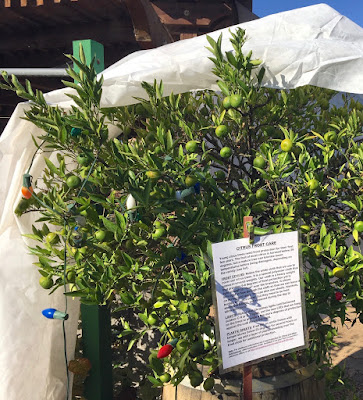
|
|
This display from the UCCE master gardeners at the Fair Oaks Horticulture
Center last year shows
some ways to protect citrus from frost: a frost
blanket and old-style
Christmas lights. The blanket of course would be
pulled over the entire
tree
if frost threatens. (Photo: Kathy Morrison)
|
Tips to help insulate your garden from too much cold
Overnight chill can kill – especially if your garden is full of frost-sensitive plants.
We’ve had a relatively warm winter with no nights below freezing (so far), but that’s likely to change. Several nights this past week have dipped into the low 30s, flirting with frost danger.
Frost damage occurs when temperatures stay below freezing for more than two hours. A “hard frost,” which is rare in Sacramento, happens when temperatures plunge to 24 degrees or lower.
Sacramento’s traditional frost period extends from early November until the first day of spring, March 21. But that frost window is getting smaller and smaller. According to the Farmer’s Almanac, our average last frost date is now Feb. 21 with a 30 percent probability that Sacramento will see frost in mid February.
Using weather data from the past decade, other observers shorten our frost forecast even more, with a last frost date of Jan. 31.
Wet weather tends to keep Valley temperatures a few degrees warmer; it’s those clear, cold winter nights that see the mercury really plunge.
With an eye on weather history and probability, we know at least a few cold nights will be on tap for January. So it’s time to be prepared. Have your frost cloths handy and be ready to bundle up your garden.
Here are more frost tips for this chilly time of year:
* If there is a frost warning, cover your sensitive plants with frost cloth, blankets or cloth sheets (not plastic) before sunset so radiant heat will help keep your plant cozy.
* Remember to uncover plants during the day (especially if it’s sunny) or they can be smothered by their frost protection.
* Harvest ripe citrus that may be harmed by frost. Don't let oranges, lemons and other fruit freeze on the tree.
* Citrus trees (particularly young trees) tend to be susceptible to frost damage. Limes are the most frost tender. Make sure they get some protection before frost hits.
* Wrap trunks of young citrus trees to insulate them from frost.
* Holiday lights – the old-fashioned kind that get hot, not LEDs – can help keep plants warm, too. Wrap a string of lights around the trunk and branches. Keep the lights on all night.
* With some exceptions, keep plants watered. Frost injury occurs when ice crystals form on leaf surfaces and draw moisture out of the leaf. The damage from dehydration is what causes frost burn.
* The exception to this rule are cactus and succulents, where saturation can cause more damage. Also, such tropical plants as bananas and hibiscus may rot if over-saturated before frost, so they prefer to be kept on the dry side.
* Don’t overprotect. Plants are more frost resistant if they’ve experienced some cold weather and winter hardening.
* If frost damage occurs, wait until March or April to prune off browned branches. That injured area will help protect the rest of the plant from further frost burn.
